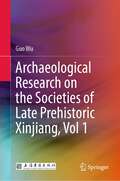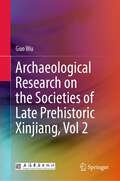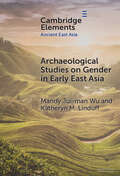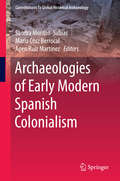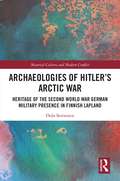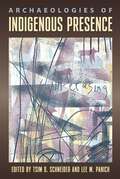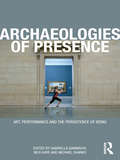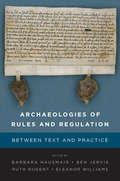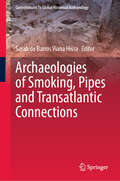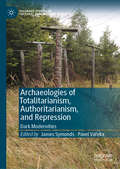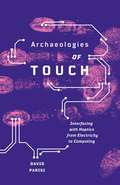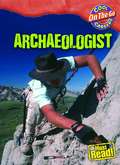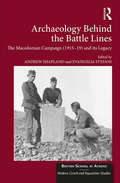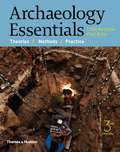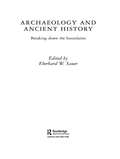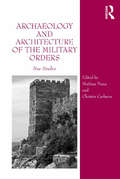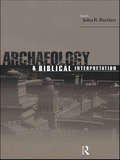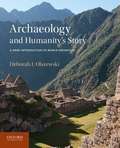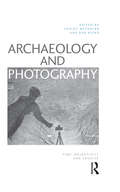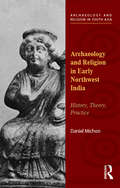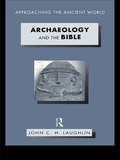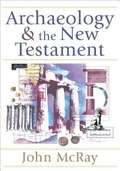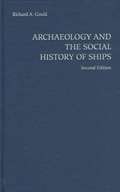- Table View
- List View
Archaeological Research on the Societies of Late Prehistoric Xinjiang, Vol 1
by Guo WuThis book presents cutting-edge archaeological materials from Xinjiang, from the Bronze Age to the early Iron Age. Through a systematic topological study of major archaeological cemeteries and sites, it establishes chronologies and cultural sequences for three main regions in Xinjiang, namely the circum-Eastern Tianshan region, the circum-Dzungarian Basin region and the circum-Tarim Basin region. It also discusses the origins and local variants of prehistoric archaeological cultures in these regions and the mutual relationships between them and neighboring cultures.By doing so, the book offers a panoramic view of the socio-cultural changes that took place in prehistoric Xinjiang from pastoral-agricultural societies to the mobile nomadic-pastoralist states in the steppe regions and the agricultural states of the oasis, making it a must-read for researchers and general readers who are interested in the archaeology of Xinjiang.
Archaeological Research on the Societies of Late Prehistoric Xinjiang, Vol 2
by Guo WuThis book presents cutting-edge archaeological materials from Xinjiang, from the Bronze Age to the early Iron Age. Through a systematic topological study of major archaeological cemeteries and sites, it establishes chronologies and cultural sequences for three main regions in Xinjiang, namely the circum-Eastern Tianshan region, the circum-Dzungarian Basin region and the circum-Tarim Basin region. It also discusses the origins and local variants of prehistoric archaeological cultures in these regions and the mutual relationships between them and neighboring cultures.By doing so, the book offers a panoramic view of the socio-cultural changes that took place in prehistoric Xinjiang from pastoral-agricultural societies to the mobile nomadic-pastoralist states in the steppe regions and the agricultural states of the oasis, making it a must-read for researchers and general readers who are interested in the archaeology of Xinjiang.
Archaeological Studies on Gender in Early East Asia (Elements in Ancient East Asia)
by Mandy Jui-man Wu Katheryn M. LinduffGendered archaeology in Asia has been studied by archaeologists since the 1990s and scholars have posed questions such as the role and construction of gendered identities in ancient societies. In this Element, the authors review secondary literature, report on to what stage the research has evolved, evaluate methodologies, and use the concept of networking to examine the issues across East Asia, including China, Mongolia, Korea, Japan, and Taiwan. Interestingly, those literatures are not entirely parallel with each other – the authors found, for example, that archaeological investigation was largely bound by national guidelines, by local intellectual traditions, and by changing historiographic interpretations of past events, as well as funding. The complexion of recent studies on gender and archaeology in Asia has often been focused on providing a framework for a grand narrative of each national 'civilization' as the emergence of institutional political structures, including traditional values placed on men and women.
Archaeologies of Early Modern Spanish Colonialism (Contributions To Global Historical Archaeology)
by Sandra Montón-Subías María Cruz Berrocal Apen Ruiz MartínezArchaeologies of Early Modern Spanish Colonialism illustrates how archaeology contributes to the knowledge of early modern Spanish colonialism and the "first globalization" of the 16th and 17th centuries. Through a range of specific case studies, this book offers a global comparative perspective on colonial processes and colonial situations, and the ways in which they were experienced by the different peoples. But we also focus on marginal "unsuccessful" colonial episodes. Thus, some of the papers deal with very brief colonial events, even "marginal" in some cases, considered "failures" by the Spanish crown or even undertook without their consent. These short events are usually overlooked by traditional historiography, which is why archaeological research is particularly important in these cases, since archaeological remains may be the only type of evidence that stands as proof of these colonial events. At the same time, it critically examines the construction of categories and discourses of colonialism, and questions the ideological underpinnings of the source material required to address such a vast issue. Accordingly, the book strikes a balance between theoretical, methodological and empirical issues, integrated to a lesser or greater extent in most of the chapters.
Archaeologies of Hitler’s Arctic War: Heritage of the Second World War German Military Presence in Finnish Lapland (Material Culture and Modern Conflict)
by Oula SeitsonenThis book discusses the archaeology and heritage of the German military presence in Finnish Lapland during the Second World War, framing this northern, overlooked WWII material legacy from the nearly forgotten Arctic front as ‘dark heritage’ – a concrete reminder of Finns siding with the Nazis – and as polluting ‘war junk’ that ruins the ‘pristine natural beauty’ of Lapland’s wilderness. The scholarship herein provides fresh perspectives to contemporary discussions on heritage perception and ownership, indigenous rights, community empowerment, relational ontologies, and the ongoing worldwide refugee crisis.
Archaeologies of Indigenous Presence
by Lee M. Panich Tsim D. SchneiderHighlighting collaborative archaeological research that centers the enduring histories of Native peoples in North AmericaChallenging narratives of Indigenous cultural loss and disappearance that are still prevalent in the archaeological study of colonization, this book highlights collaborative research and efforts to center the enduring histories of Native peoples in North America through case studies from several regions across the continent.The contributors to this volume, including Indigenous scholars and Tribal resource managers, examine different ways that archaeologists can center long-term Indigenous presence in the practices of fieldwork, laboratory analysis, scholarly communication, and public interpretation. These conversations range from ways to reframe colonial encounters in light of Indigenous persistence to the practicalities of identifying poorly documented sites dating to the late nineteenth century.In recognizing Indigenous presence in the centuries after 1492, this volume counters continued patterns of unknowing in archaeology and offers new perspectives on decolonizing the field. These essays show how this approach can help expose silenced histories, modeling research practices that acknowledge Tribes as living entities with their own rights, interests, and epistemologies.
Archaeologies of Presence
by Michael Shanks Gabriella Giannachi Nick KayeArchaeologies of Presence is a brilliant exploration of how the performance of presence can be understood through the relationships between performance theory and archaeological thinking. Drawing together carefully commissioned contributions by leading international scholars and artists, this radical new work poses a number of essential questions: What are the principle signifiers of theatrical presence? How is presence achieved through theatrical performance? What makes a memory come alive and live again? How is presence connected with identity? Is presence synonymous with 'being in the moment'? What is the nature of the ‘co-presence’ of audience and performer? Where does performance practice end and its documentation begin? Co-edited by performance specialists Gabriella Giannachi and Nick Kaye, and archaeologist Michael Shanks, Archaeologies of Presence represents an innovative and rewarding feat of interdisciplinary scholarship.
Archaeologies of Rules and Regulation: Between Text and Practice
by Barbara Hausmair Ben Jervis Ruth Nugent Eleanor WilliamsHow can we study the impact of rules on the lives of past people using archaeological evidence? To answer this question, Archaeologies of Rules and Regulation presents case studies drawn from across Europe and the United States. Covering areas as diverse as the use of space in a nineteenth-century U.S. Army camp, the deposition of waste in medieval towns, the experiences of Swedish migrants to North America, the relationship between people and animals in Anglo-Saxon England, these case studies explore the use of archaeological evidence in understanding the relationship between rules, lived experience, and social identity.
Archaeologies of Rules and Regulation: Between Text and Practice
by Eleanor Williams Barbara Hausmair, Ben Jervis, Ruth NugentHow can we study the impact of rules on the lives of past people using archaeological evidence? To answer this question, Archaeologies of Rules and Regulation presents case studies drawn from across Europe and the United States. Covering areas as diverse as the use of space in a nineteenth-century U.S. Army camp, the deposition of waste in medieval towns, the experiences of Swedish migrants to North America, the relationship between people and animals in Anglo-Saxon England, these case studies explore the use of archaeological evidence in understanding the relationship between rules, lived experience, and social identity.
Archaeologies of Smoking, Pipes and Transatlantic Connections (Contributions To Global Historical Archaeology)
by Sarah de Barros Viana HissaThis volume presents a global study of the economic and cultural global systems in which smoking materials, practices and ideas circulate, intertwine, and transform. This book compiles original work authored by researchers from the Americas, Africa, and Europe to elicit a comparative archaeology of smoking and pipes through histories and case studies from localities and regions on both sides of the Atlantic. Consequently, the book is divided into four sections divided by region. The first chapters focus on Amerindian pipes and smoking, and these are followed by research on smoking and clay pipe use in post-17th century Europe. Chapters on the production and use of clay smoking pipes in Brazil and a reflection on the influence of pipes and smoking in Senegambia comprise the final two sections respectively. Taken together, this volume explores a wide range of issues, such as economic and cultural relations between old and new worlds; the effects of colonization in different parts of the globe; circulation of ideas, practices, and objects in hegemonic and non-hegemonic transatlantic connections; techniques and styles of making and decorating pipes; materialization and expression of ethnicities and of their blurred frontiers; changes and continuities observed in smoking materials and their inferred meanings. The book compiles fresh insights on the complex and diverse history of smoking and transatlantic economic and cultural interactions associated with it. It is of interest to both historical and pre-historical archaeologists researching material culture in several regions of the world, but also historians and anthropologists interested in material culture and global cultural systems.
Archaeologies of Totalitarianism, Authoritarianism, and Repression: Dark Modernities (Palgrave Studies in Cultural Heritage and Conflict)
by James Symonds Pavel VařekaThis book offers new insights into the mechanisms of state control, systematic repression and mass violence focused on ethnic, political, class, and religious minorities in the recent past. The geographical and temporal scope of the volume breaks new ground as international scholars foreground how contemporary archaeology can be used to enhance the documentation and interpretation of totalitarian and authoritarian regimes, to advance theoretical approaches to atrocities, and to broaden public understandings of how such regimes use violence and repression to hold on to power.
Archaeologies of Touch: Interfacing with Haptics from Electricity to Computing
by David ParisiA material history of haptics technology that raises new questions about the relationship between touch and media Since the rise of radio and television, we have lived in an era defined increasingly by the electronic circulation of images and sounds. But the flood of new computing technologies known as haptic interfaces—which use electricity, vibration, and force feedback to stimulate the sense of touch—offering an alternative way of mediating and experiencing reality. In Archaeologies of Touch, David Parisi offers the first full history of these increasingly vital technologies, showing how the efforts of scientists and engineers over the past three hundred years have gradually remade and redefined our sense of touch. Through lively analyses of electrical machines, videogames, sex toys, sensory substitution systems, robotics, and human–computer interfaces, Parisi shows how the materiality of touch technologies has been shaped by attempts to transform humans into more efficient processors of information. With haptics becoming ever more central to emerging virtual-reality platforms (immersive bodysuits loaded with touch-stimulating actuators), wearable computers (haptic messaging systems like the Apple Watch&’s Taptic Engine), and smartphones (vibrations that emulate the feel of buttons and onscreen objects), Archaeologies of Touch offers a timely and provocative engagement with the long history of touch technology that helps us confront and question the power relations underpinning the project of giving touch its own set of technical media.
Archaeologist (Cool on the Go Careers)
by William David ThomasWhat do bone fragments, pieces of cracked pottery, and crystal skulls have in common? Archaeologists have found them all! Discover how archaeologists research where to dig, what to look for, and how to date and catalog the artifacts they find. Dig up the secrets of archaeology and learn the skills needed to succeed in this amazing field.
Archaeology Behind the Battle Lines: The Macedonian Campaign (1915-19) and its Legacy (British School at Athens - Modern Greek and Byzantine Studies #4)
by Andrew Shapland Evangelia StefaniThis volume focuses on a formative period in the history and archaeology of northern Greece. The decade following 1912, when Thessaloniki became part of Greece, was a period marked by an extraordinary internationalism as a result of the population movements caused by the shifting of national borders and the troop movements which accompanied the First World War. The papers collected here look primarily at the impact of the discoveries of the Army of the Orient on the archaeological study of the region of Macedonia. Resulting collections of antiquities are now held in Thessaloniki, London, Paris, Edinburgh and Oxford. Various specialists examine each of these collections, bringing the archaeological legacy of the Macedonian Campaign together in one volume for the first time. A key theme of the volume is the emerging dialogue between the archaeological remains of Macedonia and the politics of Hellenism. A number of authors consider how archaeological interpretation was shaped by the incorporation of Macedonia into Greece. Other authors describe how the politics of the Campaign, in which Greece was initially a neutral partner, had implications both for the administration of archaeological finds and their subsequent dispersal. A particular focus is the historical personalities who were involved and the sites they discovered. The role of the Greek Archaeological Service, particularly in the protection of antiquities, as well as promoting excavation in the aftermath of the 1917 Great Fire of Thessaloniki, is also considered.
Archaeology Essentials: Theories, Methods, and Practice
by Colin Renfrew Paul BahnArchaeology Essentials, already the most authoritative and accessible introduction on the market, has been updated with new discoveries, new technological innovations, revised pedagogical features, and improved illustrations. Written for today's students, Archaeology Essentials is rigorous without being over-technical and thorough without being overwhelming. The only truly global archaeology textbook available in full color, the text also provides guidance for aspiring archaeologists in the form of compelling interviews with a worldwide selection of practicing archaeologists. The third edition of Archaeology Essentials is destined to become a classic of the field.
Archaeology For Young Explorers: Uncovering History At Colonial Williamsburg
by Patricia Samford David L. RibblettYoung explorers can investigate Williamsburg's colonial capital along with the archaeologists. They will learn why artifacts end up in the ground, how archaeologists know where to dig, what they find when they excavate, what they do with those findings, and what they learn from their discoveries.
Archaeology and Ancient History: Breaking Down the Boundaries
by Eberhard W. SauerChallenging both traditional and fashionable theories, this collection of pieces from an international range of contributors explores the separation of the human past into history, archaeology and their related sub-disciplines. Each case study challenges the validity of this separation and asks how we can move to a more holistic approach in the study of the relationship between history and archaeology. While the focus is on the ancient world, particularly Greece and Rome, rhe lessons learnded in this book make it an essential addition to all studies of history and archaeology.
Archaeology and Architecture of the Military Orders: New Studies
by Mathias Piana Christer CarlssonAs elite communities in medieval societies the Military Orders were driven by the ambition to develop built environments that fulfilled monastic needs as well as military requirements and, in addition, residential and representational purposes. Growing affluence and an international orientation provided a wide range of development potential. That this potential was in fact exploited may be exemplified by the advanced fortifications erected by Templars and Hospitallers in the Levant. Although the history of the Military Orders has been the subject of research for a long time, their material legacy has attracted less attention. In recent years, however, a vast range of topics concerning the Orders’ building activities has become the object of investigation, primarily with the help of archaeology. They comprise the choice of sites and building materials, provision and storage of food and water, aspects of the daily life, the design and layout of commanderies, churches and fortifications, their spatial arrangement, and the role these buildings played in their environmental context. This volume contains ten articles discussing the archaeology and architecture of buildings erected by the three major Military Orders in different geographical regions. They cover most countries of Western Europe and include a number of important fortifications in the Levant. These studies break new ground in the investigation of the built fabric of the Military Orders. Written by noted international scholars this publication is an important contribution to modern research on these institutions, which, in their association of monasticism and knighthood, were so typical for the Middle Ages.
Archaeology and Biblical Interpretation
by John R. BartlettThe contributors in this book use the most recent research in key areas - the early settlements of Israel, early Israelite religion, Qumran, Jerusalem, early Christian churches - to show that ancient writings and modern archaeology can illuminate each other, but only when used with professional care. The essays represent a new generation of archaeologists and historians, with new social, political and religious concerns who draw a fresh and vital picture of the emergence of ancient Israel.
Archaeology and Humanity's Story: A Brief Introduction To World Prehistory
by Deborah I. OlszewskiThis student-friendly textbook introduces the archaeological past from approximately seven million years ago through later politically complex societies. Archaeology and Humanity's Story: A Brief Introduction to World Prehistory does not attempt to discuss every archaeologically important site and development in prehistory and early history. Rather, it presents key issues from earlier prehistory and then organizes the chapters on politically complex societies using a similar framework. This allows students to easily compare and contrast different geographical regions. Each of these chapters also highlights a specific case study in which similar themes are examined, such as the written word; resource networks, trade, and exchange; social life; ritual and religion; and warfare and violence. Each chapter includes several sidebar boxes, a timeline showing the chronology relevant to that chapter, and "The Big Picture," "Peopling the Past," and "Evolutionary Processes" features.
Archaeology and Photography: Time, Objectivity and Archive
by Lesley McFADYENDoes a photograph freeze a moment of time? What does it mean to treat a photographic image as an artefact? In the visual culture of the 21st century, do new digital and social forms change the status of photography as archival or objective – or are they revealing something more fundamental about photography’s longstanding relationships with time and knowledge?Archaeology and Photography imagines a new kind of Visual Archaeology that tackles these questions. The book reassesses the central place of Photography as an archaeological method, and re-wires our cross-disciplinary conceptions of time, objectivity and archives, from the History of Art to the History of Science.Through twelve new wide-ranging and challenging studies from an emerging generation of archaeological thinkers, Archaeology and Photography introduces new approaches to historical photographs in museums and to contemporaryphotographic practice in the field. The book re-frames the relationship between Photography and Archaeology, past and present, as more than a metaphor or an analogy – but a shared vision.Archaeology and Photography calls for a change in how we think about photography and time. It argues that new archaeological accounts of duration and presence can replace older conceptions of the photograph as a snapshot orremnant received in the present. The book challenges us to imagine Photography, like Archaeology, not as a representation of the past and the reception of traces in the present but as an ongoing transformation of objectivity and archive.Archaeology and Photography will prove indispensable to students, researchers and practitioners in History, Photography, Art, Archaeology, Anthropology, Science and Technology Studies and Museum and Heritage Studies.
Archaeology and Religion in Early Northwest India: History, Theory, Practice (Archaeology and Religion in South Asia)
by Daniel MichonThis book explores the ways in which past cultures have been used to shape colonial and postcolonial cultural identities. It provides a theoretical framework to understand these processes, and offers illustrative case studies in which the agency of ancient peoples, rather than the desires of antiquarians and archaeologists, is brought to the fore.
Archaeology and the Bible (Approaching the Ancient World)
by John LaughlinThis book challenges readers to consider whether archaeology explains the Bible.Archaeology and the Bible examines new developments in archaeological finds in the Near East, particularly Palestine, that are related to the Bible. New methodologies, regional surveys and creative syntheses have all had an impact on traditional approaches to looking at these discoveries. John Laughlin examines these new developments and discusses what they imply for biblical studies.
Archaeology and the New Testament
by John McRayAs he tours sites associated with the ministry of Jesus, the journey of Paul, and the seven churches of Revelation, he shows the pervasive influence of society, architecture, and religion on the peoples of the first century and on the New Testament.
Archaeology and the Social History of Ships
by Richard A. GouldMaritime archaeology deals with shipwrecks and is carried out by divers rather than diggers. It embraces maritime history and analyses changes in shipbuilding, navigation and seamanship and offers fresh perspectives on the cultures and societies that produced the ships and sailors. Drawing on detailed past and recent case studies, Richard A. Gould provides an up-to-date review of the field that includes dramatic new findings arising from improved undersea technologies. This second edition of Archaeology and the Social History of Ships has been updated throughout to reflect new findings and new interpretations of old sites. The new edition explores advances in undersea technology in archaeology, especially remotely operated vehicles. The book reviews many of the major recent shipwreck findings, including the Vasa in Stockholm, the Viking wrecks at Roskilde Fjord and the Titanic.
